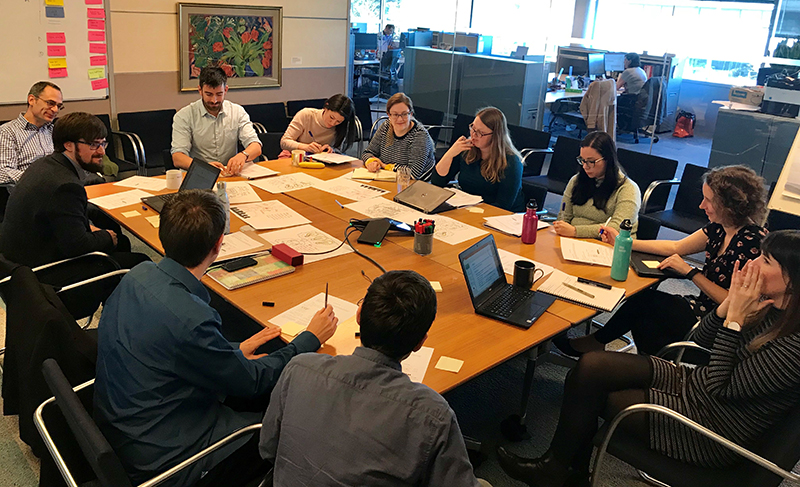celebrating-the-ecology-journals-driving-impact
July 09, 2020
Wiley and our society partners play a key role in shaping the direction of research in Ecology, publishing six of the top ten ranked journals by impact factor in the field:
- Frontiers in Ecology & the Environment (9.275)
- Ecology Letters (8.655)
- Global Change Biology (8.555)
- Ecological Monographs (7.722)
- Methods in Ecology and Evolution (6.511)
- Ecography (6.455)
In total, Wiley has 39 journals with an impact factor in the ISI Ecology category, covering every niche and topic. The quality and breadth of these titles mean that every ecological researcher has a journal at Wiley that can provide a home for their research – from highly novel and impactful work, to more specific and localized studies. Given the scale of our portfolio, our editors can work together to ensure your paper is published in the most suitable journal. In short, there is a home for every paper.
We are keen to make the research we publish as impactful as possible, as well as helping to shape the future of the field. Here are some examples of what we see as key trends and developments.
Biogeography
Recently, there has been an explosion of interest in biogeography, ranging from phylogenetics to species distribution modeling, and everything in between. Wiley has a strong presence across all these sub-disciplines, with Journal of Biogeography, Global Ecology and Biogeography, Diversity and Distributions, and Ecography (published on behalf of the Nordic Society Oikos) all publishing high impact work. Aligning this field to the needs of researchers and enabling publication as open access has long been a priority. Diversity and Distributions and, more recently, Ecography are now pure ‘Gold’ open access journals, meaning work published here will be immediately available and free to read to any researcher across the globe. Wiley has a number of agreements in place with institutions and funders to help authors publish open access and ensure compliance with open access policies. You can visit our affiliation policy and payments page to check whether your institution or funder is eligible. Specifically, we’ve also seen increased interest in comparative phylogeography and functional biogeography, and Journal of Biogeography drives research forward in these areas.
Environmental DNA
Environmental DNA, or eDNA, has emerged as a convenient tool for biomonitoring, especially in aquatic systems. We recently launched an open access journal dedicated purely to advances in this field, Environmental DNA, and have special issues planned from Diversity & Distributions (‘eDNA-based biodiversity assessment and conservation management’) and Molecular Ecology (‘Environmental DNA for biodiversity and ecosystem monitoring’). Freshwater Biology is also looking to expand its focus in this area. These serve to highlight the increasing importance of the technique, evidenced by strong submissions across our portfolio.
Impact of human activity
The practitioner-led application of ecological learnings will also continue to be important, as human activity increasingly impacts on ecosystems worldwide. Wiley and the British Ecological Society have recently launched two new journals to help researchers get this work to as many readers as possible. People & Nature is directed at research areas exploring interesting questions about the relationships between humans and nature, while Ecological Solutions and Evidence will publish work that has direct relevance for the management of biological resources and ecological systems. Work like this will be invaluable in the future, and to ensure widest possible dissemination, both are open access. Authors have a real opportunity to help shape the field with innovative publishing options such as Registered Reports.
Other special issues
Other fascinating upcoming special issues that will look closely at our changing climate include a series on arid land restoration from Restoration Ecology, a look at the increasing impact of wildfires (‘fire ecology for the 21st century: conserving biodiversity in the age of megafire’) from Diversity & Distributions and ‘Ecological change in Arctic fresh waters’ from Freshwater Biology. Researchers publishing in all these special issues will be able to benefit from the support of dedicated editors who are experts in their field.
Impact of COVID-19
The devastating effect of COVID-19 will continue to be felt throughout every scientific discipline and beyond. Our ecology portfolio will be looking at how the pandemic has, and will, affect our discipline. Ecological Solutions & Evidence will be examining how global policy and ecology will interact as a result, while Ecology & Evolution will be publishing a special issue entitled ‘Taking Learning Online in Ecology and Evolution’ assessing how academics have rapidly adapted to socially distanced educational practices. Ecosphere (an open access journal published on behalf of the Ecological Society of America) is also looking at the interface between ecology and education, with a new ‘Eco-Education’ subject track.
These are just a selection of the initiatives Wiley is developing to help make your research available, widely read, and disseminated. As a researcher, you can also help maximize the impact of your published work and ensure that it gets seen and cited, from simple steps such as including a link to your article in your email signature, or sharing via social media, to publicizing the work via a press release. For more tips on driving the impact of your work, visit Wiley’s guide to promotion page.
Enjoy free access to top-cited articles until 30th July 2020.
Microplastics as an emerging threat to terrestrial ecosystems
Anderson Abel Souza Machado, Werner Kloas, Christiane Zarfl, Stefan Hempel, Matthias C. Rillig
Global Change Biology
Evidence for declining forest resilience to wildfires under climate change
Camille S. Stevens-Rumann, Kerry B. Kemp, Philip E. Higuera, Brian J. Harvey, Monica T. Rother et al.
Ecology Letters
Conceptual and statistical problems with the DEC+J model of founder-event speciation and its comparison with DEC via model selection
Richard H. Ree, Isabel Sanmartín
Journal of Biogeography
Biodiversity change is uncoupled from species richness trends: Consequences for conservation and monitoring
Helmut Hillebrand, Bernd Blasius, Elizabeth T. Borer, Jonathan M. Chase, John A. Downing et al.
Journal of Applied Ecology
Paintings predict the distribution of species, or the challenge of selecting environmental predictors and evaluation statistics
Yoan Fourcade, Aurélien G. Besnard, Jean Secondi, Michael Borregaard
Global Ecology and Biogeography
Scrutinizing key steps for reliable metabarcoding of environmental samples
M. Thomas P. Gilbert, Kristine Bohmann, Ostaizka Aizpurua, Antton Alberdi, Andrew Mahon
Methods in Ecology and Evolution
The role of dispersal in river network metacommunities: Patterns, processes, and pathways
Jonathan D. Tonkin, Florian Altermatt, Debra S. Finn, Jani Heino, Julian D. Olden et al.
Freshwater Biology
Call for a Paradigm Shift in the Genetic Management of Fragmented Populations
Katherine Ralls, Jonathan D. Ballou, Michele R. Dudash, Mark D. B. Eldridge, Charles B. Fenster et al.
Conservation Letters
ENVIREM: an expanded set of bioclimatic and topographic variables increases flexibility and improves performance of ecological niche modeling
Pascal O. Title, Jordan B. Bemmels
Ecography
Satellite remote sensing of ecosystem functions: opportunities, challenges and way forward
Nathalie Pettorelli, Henrike Schulte to Bühne, Ayesha Tulloch, Grégoire Dubois, Cate Macinnis-Ng et al.
Remote Sensing in Ecology and Conservation
Species co-occurrence networks: Can they reveal trophic and non-trophic interactions in ecological communities?
Mara A. Freilich, Evie Wieters, Bernardo R. Broitman, Pablo A. Marquet, Sergio A. Navarrete
Ecology
Diel predator activity drives a dynamic landscape of fear
Michel T. Kohl, Daniel R. Stahler, Matthew C. Metz, James D. Forester, Matthew J. Kauffman et al.
Ecological Monographs
Comammox Nitrospira are abundant ammonia oxidizers in diverse groundwater-fed rapid sand filter communities
Susan Jane Fowler, Alejandro Palomo, Arnaud Dechesne, Paul D. Mines, Barth F. Smets
Environmental Microbiology
South-western Atlantic reef fishes: Zoogeographical patterns and ecological drivers reveal a secondary biodiversity centre in the Atlantic Ocean
Hudson T. Pinheiro, Luiz A. Rocha, Raphael M. Macieira, Alfredo Carvalho-Filho, Antônio B. Anderson et al.
Diversity and Distributions
The ‘golden kelp’ Laminaria ochroleuca under global change: Integrating multiple eco-physiological responses with species distribution models
João N. Franco, Fernando Tuya, Iacopo Bertocci, Laura Rodríguez, Brezo Martínez et al.
Journal of Ecology
Satellite sensor requirements for monitoring essential biodiversity variables of coastal ecosystems
Frank E. Muller-Karger, Erin Hestir, Christiana Ade, Kevin Turpie, Dar A. Roberts et al.
Ecological Applications
Individual heterogeneity and capture-recapture models: what, why and how?
Olivier Gimenez, Emmanuelle Cam, Jean-Michel Gaillard
Oikos
Gut microbial communities of American pikas (Ochotona princeps): Evidence for phylosymbiosis and adaptations to novel diets
Kevin D. Kohl, Johanna Varner, Jennifer L. Wilkening, M. Denise Dearing, Bethany Hoye
Journal of Animal Ecology
sPlot - A new tool for global vegetation analyses
Helge Bruelheide, Jürgen Dengler, Borja Jiménez-Alfaro, Oliver Purschke, Stephan M. Hennekens et al.
Journal of Vegetation Science
Bark beetles as agents of change in social-ecological systems
Jesse L Morris, Stuart Cottrell, Christopher J Fettig, R Justin DeRose, Katherine M Mattor et al.
Frontiers in Ecology and the Environment












